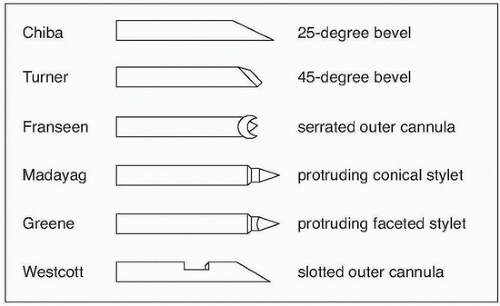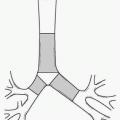Needles, Guidewires, Catheters, and Stents
David W. Trost
An understanding of needles, guidewires, catheters (vascular and nonvascular), balloons, and stents with respect to their material and dimensional characteristics is very important because of how these devices are made and measured and how these scales relate to one another and the device’s general physical behavior.
Dimensional scales of gauge, French, inches, and millimeter are commonly used to measure the diameter of interventional devices, causing confusion even
among seasoned practitioners. Needles are measured in gauge, guidewires in inches, catheters in French, and balloons and stents in millimeters. The gauge (Birmingham Wire Gauge, developed in the 1800s) specifies the outer diameter (OD) of the needle, with smaller diameters counter intuitively having higher values. French size, developed by the French medical instrument-maker, Joseph-Frédéric-Benoît Charrière, refers to the outer circumference a device, with one French size equaling approximately 0.33 mm (e.g., 3 Fr. OD ˜1.0 mm OD). Inches and millimeters are self-explanatory and refer to the nominal OD (or length) of a device. Sizing scale conversions are outlined in Table e-92.1.
among seasoned practitioners. Needles are measured in gauge, guidewires in inches, catheters in French, and balloons and stents in millimeters. The gauge (Birmingham Wire Gauge, developed in the 1800s) specifies the outer diameter (OD) of the needle, with smaller diameters counter intuitively having higher values. French size, developed by the French medical instrument-maker, Joseph-Frédéric-Benoît Charrière, refers to the outer circumference a device, with one French size equaling approximately 0.33 mm (e.g., 3 Fr. OD ˜1.0 mm OD). Inches and millimeters are self-explanatory and refer to the nominal OD (or length) of a device. Sizing scale conversions are outlined in Table e-92.1.
The internal diameter (ID) will vary with the thickness of the wall of the device. Because the introduction of these devices into the body requires sliding one through another, it is essential to know the relationships of these measuring standards. The rule of thumb is that 19 gauge, 3 Fr., 0.038 in., and 1 mm are all about the same size. The ID of devices in not standardized but varies with specifications for the device. Some devices are labeled by the French size of the device they accommodate; sheaths and guiding catheters are labeled in this manner. Sometimes, even devices that should fit through each other based on the labeling may not do so due to variances in manufacturing tolerances. For example, a sheath 5 Fr. labeling should accept a 5 Fr. catheter. If the catheter is at the upper limits of its manufacturing tolerances and the sheath is at the lower limits of its tolerances, then the system might not fit. This is rare but can happen, especially when the manufacturers are different. Other factors that can affect the fit are dry blood or contrast on a catheter or guidewire, which can distort dimensions or create excessive friction. This is especially important with small-diameter devices, which have tighter tolerances. Hydrophiliccoated devices must always be kept wet in order for them to perform properly.
Table e-92.1 Sizing Scale Conversions | ||||||||||||||||||||||||||||||||||||||||||||||||||||||||||||||||||||||||||||||||||||||||||||||||||||
|---|---|---|---|---|---|---|---|---|---|---|---|---|---|---|---|---|---|---|---|---|---|---|---|---|---|---|---|---|---|---|---|---|---|---|---|---|---|---|---|---|---|---|---|---|---|---|---|---|---|---|---|---|---|---|---|---|---|---|---|---|---|---|---|---|---|---|---|---|---|---|---|---|---|---|---|---|---|---|---|---|---|---|---|---|---|---|---|---|---|---|---|---|---|---|---|---|---|---|---|---|
|
Needles
Although the basic concept of a needle is simple, there are many permutations of the basic design that are optimized for specific tasks. Almost every procedure that is performed by the interventionalist begins with the choice of a specific needle.
The concept of “form follows function” really applies to needle design. Needles, generally made from surgical stainless steel, come in many sizes and lengths. Short squat needles do not bend when introduced into soft tissue, but thin longer ones can bend and miss deeper targets unless guided properly. Needles are generally hollow, may be filled with an inner removable trocar, and are categorized broadly for access or biopsy.
Access needles usually have a wedge-shaped tip or a trocar (simple-pointed) tip. The OD is specified by its gauge, whereas the ID varies with the wall thickness. In general, a 19-gauge needle will accept a 0.035-in. guidewire, and a 21-gauge needle accepts a 0.018-in. guidewire. Access needles are used to enter structures such as blood vessels (see Fig. 1.2), organs, and collections. They are designed to penetrate soft tissue to the desired target and then allow injection of fluid, usually contrast, or allow the passage of a guidewire, once the trocar is removed.
Biopsy needles are designed to remove tissue for microbiologic or pathologic analysis (see Fig. e-92.1). There are fine needle aspiration (FNA) needles and core biopsy needles. FNA




Stay updated, free articles. Join our Telegram channel

Full access? Get Clinical Tree






